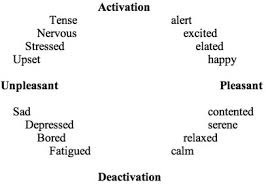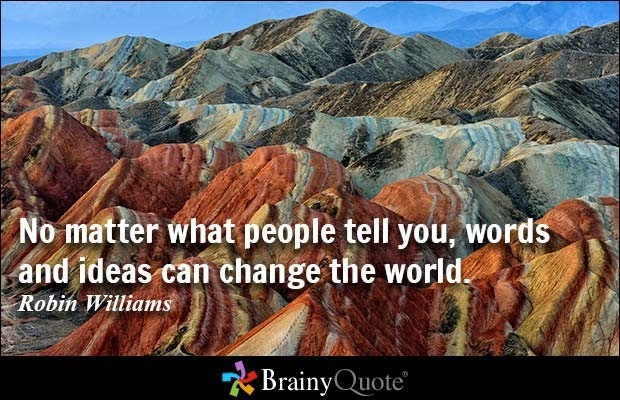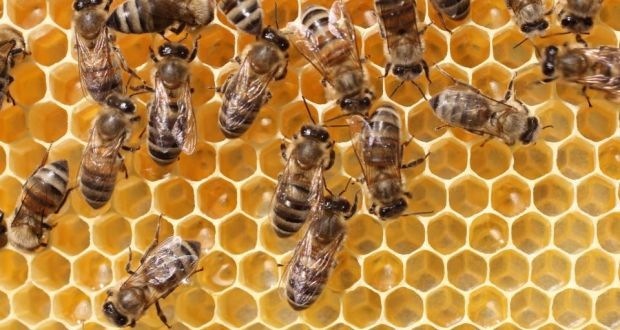Developing a Tolerance to Negativity

The writers and readers who participate in the discussions found on beBee provide such a great source of energy to think, learn, grow and succeed. And it’s all for free! How can not everyone be taking advantage of this great resource?
This buzz is a direct result of a buzz produced by @Ali Anani and a comment from @Harvey Lloyd.
Please look at the direction in which their ideas have propelled me and respond with your thoughts, insights and perspectives.
Discussion: Do negatives, in this case negative emotions, have any benefit or role in enabling us to function to our optimum?
In his buzz, The Positive Side of Negative Emotions, @Ali Anani states: “…separation thinking goes against nature because opposites co-exist.”
Dr. Ali provides a cornerstone in understanding how important it is to see the whole picture. If opposites co-exist, then engaging in only one side of things is preventing us from being completely functional; something is missing.
In one of my comments to Dr. Ali’s buzz I say, "Emotion is a label for feelings which are universally agreed upon but subjectively experienced."
@Harvey Lloyd responded to this comment by saying, “…the implications to self-awareness are meaningful…I can see the cognitive dissonance within the statement… Our universal understanding of "emotions" appears to be congruent. In reality or our own actions the understanding is different, the "duality".”
The three ideas that I am now carrying over from the buzz and comment are the following:
1. Separation goes against nature.
2. The concept of cognitive dissonance.
3. The duality: The communal sense of an emotion and the meaning that the individual gives to that emotion are not always congruent.
1. Opposites Do Not Exist; Opposites Are Created
In both our personal and professional lives, it is more manageable to work with ideas, strategies, plans, goals, relationships, feelings and so on, if we place them in an opposite:
Life/Death; Good/Evil; Right/Wrong; Pleasure/Pain; Love/Hate; Beautiful/Ugly; Rich/Poor; Success/Failure; to name just a few.
These states, however useful they are in organizing ourselves, do not exist; they have been created by us to help us make sense of who we are, in relation to others, and our environment.

Embedded in this distinction and separation are formed judgments of good and bad, positive and negative. So one may determine that being in a state of anger is wrong and we should strive to be in a state of calm by giving meaning to anger as something bad, negative, or destructive and to calm as the better state, right and positive.
Image credit: Quantified Self
It is necessary to see this drive to compartmentalize, to create opposites, as a defense strategy gone wrong.
We have an innate drive towards homeostasis and balance. Somehow along the way, we associated this place of homeostasis as one in which we are comfortable. Therefore, anything that causes a sense of discomfort must be avoided or negated. This is man-made, not found in nature. The process of homeostasis is a dynamic one; only by experiencing a state of disequilibrium can we then make choices of where to go or what action to take in order to help us move towards equilibrium. In a way, we can say that we can’t achieve equilibrium without knowing how to tolerate and work with the disequilibrium. Because the two states coexist, we need to learn how to be in that tension of coexistence. Maybe if we would re-frame how we see emotions, we would feel comfortable in the tension and uncomfortable being in one state of emotion without its “other side”.
2. This is where cognitive dissonance takes place.
I have taken the following key aspects of cognitive dissonance from the discussion found on Wikipedia:
“In psychology, cognitive dissonance is the mental stress or discomfort experienced by an individual who holds two or more contradictory beliefs, ideas, or values at the same time; performs an action that is contradictory to their beliefs, ideas, or values; or is confronted by new information that conflicts with existing beliefs, ideas or values.
Leon Festinger's theory of cognitive dissonance focuses on how humans strive for internal consistency. An individual who experiences inconsistency tends to become psychologically uncomfortable, and is motivated to try to reduce this dissonance, as well as actively avoid situations and information likely to increase it.
The amount of dissonance produced by two conflicting cognitions or actions (as well as the subsequent psychological distress) depends on two factors:
1. The importance of cognitions: The more the elements are personally valued, the greater the magnitude of the dissonant relationship.
2. Ratio of cognitions: The proportion of dissonant to consonant elements.”
A classic example of cognitive dissonance is the following:
An individual holds the belief that lying is wrong and finds her/himself in a situation where s/he is being forced to lie.
First, what is important to highlight is that the individual finds her/himself in a situation in which s/he feels out of control, this will determine the outcome. The emotions and feelings attached to being out of control will determine the level of discomfort and the degree of dissonance taking place and based on that, the individual will choose how to respond. If s/he feels that it is necessary to lie, rather than not lying, the individual will change her or his attitude by claiming that s/he believes in the lie.
3. How do we experience emotion?
Antonio D’Amasio describes the relationship between emotions and feelings in the following way:
“Feelings are mental experiences of body states, which arise as the brain interprets emotions, themselves physical states arising from the body’s responses to external stimuli. (The order of such events is: I am threatened, experience fear, and feel horror.)”
Whereas emotions communicate through the body information that we need to know in order to protect ourselves, feelings are mental associations and reactions to emotions. We give feelings subjective meanings based on our experiences. This process of assigning meanings involves cognitive input. More often than not, this input is experienced on a subconscious level.

Awareness of this dynamic process which goes on all the time and in every environment is crucial in determining how we relate to ourselves, others and our environment.
Image credit: Pinterest
A clinical example:
In my work as a therapist, I consider the therapy room, the materials I use and my engagement with the individual or group as the structuring of a container. When I use music listening, the instrumental music is the container within which the work will take place next. The structure of the music; a clear beginning, middle and end, determines the boundaries of the container. The size of the container is determined by the complexity of the musical elements found in the piece; how many melodic “voices” (all instrumental) are used, how many instruments, how many changes in harmony, tempo and rhythm, all influence the size and space of the music container within which the therapy work will take place. All elements factor into the tension held within the container and experienced by the individual or the group. Within the music structure there are built-in resolutions to these tensions, resolutions which are anticipated by the listeners. It is the ability to anticipate the resolution that enables the listener to tolerate the tension.
A business example:
As a team leader, it is my responsibility to present as much information and lay down as clear a structure as possible. If I want to challenge by team members to creatively find resolutions to company problems, the message has to be that my expectation is in the effort of the process, not in a final product. The members have to feel that they have room to maneuver but that there is support at the ready. The team members need to feel that the work is not focused on success or failure but in coming up with as many options as possible. In other words, to enable each team member to hold the tension related to the project rather to any inferred messages of risk taking.
In conclusion:

No man has the right to dictate what other men should perceive, create or produce, but all should be encouraged to reveal themselves, their perceptions and emotions, and to build confidence in the creative spirit.
Ansel Adams
All emotions have a role in our ability to function, grow and develop to our potential. Some have negative qualities, while other have positive. Together they create a whole experience.
Being aware of our emotions and being able to tolerate and hold tension is hard work. Please remember to provide yourself with spaces of rest. Remember to breathe.
Flowers are restful to look at. They have neither emotions nor conflicts.
Sigmund Freud

Articles from Sara Jacobovici
View blog
Welcome to Wednesday Word(s) of the Week at beBee: WWW.beBee · My contribution for this week is · a ...

I am posting this is an “Out of the Comment Box” buzz as I am catching up on the works of some of th ...

Image credit: steveoatesblog - WordPress.com · With Q&A@beBee, I ask some of the most interesting pe ...
Related professionals
You may be interested in these jobs
-

Clinical Development Scientist
1 day ago
Philips Haifa, Israel Full timeJob Title · Clinical Development ScientistJob Description · As Clinical Development Scientist you will develop the clinical evidence strategy, execution and dissemination in support of assigned CT-AMI programs. You will provide input to the cross-functional team through strong cr ...
-

Chief of Staff to the CEO
1 day ago
StarkWare Netanya, Israel Full timeStarkWare is looking to hire a Chief of Staff to the CEO to join their team. This is a full-time position that is based in Netanya. ...
-

Administrative Officer
6 days ago
United Nations Children's Fund Jerusalem, Israel· Job Description · Description · –> · UNICEF in the State of Palestine works to uphold the rights of children to access services and protection, from early childhood through to adolescence. Our objective is to ensure that every child in the Gaza Strip and the West Bank, includi ...
Comments
Sara Jacobovici
6 years ago #37
Sara Jacobovici
7 years ago #36
Nice share and powerful ending @Jared Wiese. Thanks
Sara Jacobovici
7 years ago #35
No rambling here @Jared Wiese but your perspective and insights. Thanks for sharing. When you write, "Until we reach a threshold, we probably will not really change the circumstances that got us, stung.", it reminds me of Carl Rogers quote, "The curious paradox is that when I accept myself just as I am, then I can change."
Sara Jacobovici
7 years ago #34
Sara Jacobovici
7 years ago #33
Part 1/2 Thank you @Nikki Petersen for taking the time to read my post and for your comment. I appreciate you bringing up trust/mistrust as they are are an important contribution to this discussion. You write, "For us to create the trust that enables the sitting with the tension, there also has to be mistrust. There has to be doubt that the outcome will be what we hope it will be." My sense of this is a mature view point; something we are able to form out of accumulated experiences, whereas trust and mistrust are formed very early on in human development. It's not a matter of hope for the newborn and infant to have his or her needs met, its an expectation. The newborn or infant trusts that his or her physical and emotional needs will be met; it's unspoken and innate. It is when those needs are not met that mistrust begins to form and produces feelings/sensations related to anxiety. In any group, individuals bring their own meanings formed from experiences related to expectations and will either be "naively" open in their trust or on the other end of the spectrum, suspicious, or anywhere in between. Trust is earned; we shouldn't trust anyone until they have proven that they are trustworthy. In terms of my clinical work I remind my client of that. I have to work hard at earning his or her trust. As well, I remind my client that there are three aspects to the trust in the work; they need to trust themselves that they will do what they need or able to do in their work, trust the medium; whether the talking or the creative arts materials and process, and then there is me, where the client can take the time to develop that trust.
Sara Jacobovici
7 years ago #32
Thanks for your encouraging remark about my post Jim Murray. As for the rest, I defend your right to saying what needed to be said.
Sara Jacobovici
7 years ago #31
As you said @Max Carter, you disagree. And so, at the risk of sounding cliche, I respectfully agree to disagree.
Sara Jacobovici
7 years ago #30
Read it and admired it Ali Anani
Sara Jacobovici
7 years ago #29
Thank you @Jared Wiese for your very valuable contribution to this discussion. Much appreciated.
Sara Jacobovici
7 years ago #28
An invaluable comment and a great contribution to the discussion @Jared Wiese. Well written! You have given me more to consider in my work as I pull together an equation that results in action. I look forward to inlcuding your comment (with proper credit) in my work. Thanks. Ali Anani, I see this as relevant to the process of the equation or in adding the equation of choice. Lots of work, but well worth it. Plus as I am working on the real work example of the fractal trajectories of emotions and am beginning to think that the equation(s) is connected. Again, lots of work. Attention to all readers and Javier beBee. I am experiencing, in real time, a cross pollination in which I am commenting on this post on how Jared's comment adds to the work I am doing as a result of another post. As well, I found myself this morning cross pollinating across social network when I shared on beBee a post from linkedin which also supports the work I am doing and contributes to the discussion I have had on beBee. I am writing all this as to show how the idea of affinity and engagement, and beBee's role as a bridge with other networks is coming to life on a daily basis. Hurray to all!
Sara Jacobovici
7 years ago #27
If I understand your point @Jared Wiese, there is an increased impact with the number of "stings". Very true, how we cope with one onslaught is often easier than those coming from a mass. The complexity lies in the fact that each individual is unique in how their system responds. Some are allergic to bee stings and are very threatened by that single sting. While others have built up a strong netting that doesn't allow the bees to penetrate.
Sara Jacobovici
7 years ago #26
"I hope you understand it;s the concepts I am debating not you as a person, we just happen to wind up in this location for the opportunity for both to share and grow." 100%
Sara Jacobovici
7 years ago #25
Sara Jacobovici
7 years ago #24
All the power to you @Max Carter. I mean that sincerely. You are committed to a viewpoint that has made a difference in your life and you are helping others do the same. Each journey is different. In a way, I consider everything we do as a movement towards unity, but what that unity means or looks like is still abstract. Also, how can I move towards unity without experiencing and being in the different state of separation? The one thing that I can relate to is when you say, "if one hangs on to concepts such as duality it can cause a psychotic episode and a split personality to form." You can substitute any word for duality and then have other lists of causes attached anytime we get stuck in one isolated view of the world.
Sara Jacobovici
7 years ago #23
Thanks for sharing your perspective @Max Carter. From my perspective duality exists from preconception; you can't form life without the two coming together to form the one. The two existed before the formation of the one. We wouldn't be here exchanging our point of views if it were not for the existence of duality coming together to form us. Along our road of development, growth, interaction with ourselves, others and our environment, we take fragments of our experiences and we create whole meanings. Each meaning then becomes a fragment of a bigger whole and so on. Meanings fall into other fragments such as beliefs and value, and so on...The meaning of tolerance is one that is being explored here. Ideas are being exchanged, shared and discussed. I find this a healthy environment. We are engaged in an intellectual exercise; we are building thought muscles. F. Scott Fitzgerald wrote, "The test of a first-rate intelligence is the ability to hold two opposed ideas in mind at the same time and still retain the ability to function." I share that point of view.
Sara Jacobovici
7 years ago #22
Sara Jacobovici
7 years ago #21
Thank you Don Kerr. Appreciate your response.
Sara Jacobovici
7 years ago #20
Please see Deb's comment #46 Ali Anani.
Sara Jacobovici
7 years ago #19
Please take care of yourself (your physical self) CityVP Manjit. Remember, your brain needs a minimum amount of deep sleep.
Sara Jacobovici
7 years ago #18
What a gift! Thank you Deb Lange as it didn't get highlighted in your comment.
CityVP Manjit
7 years ago #17
My thanks is to you and Ali Anani post tomorrow morning and your and Ali Anani's response tomorrow. If I have time I should be able to pop into beBee around 8pm tonight, otherwise I hope my trusted alarm clock does its job tomorrow.
Sara Jacobovici
7 years ago #16
#44 Thank you CityVP Manjit for taking the time to read, respond and share. Your "comments" expand the points being discussed in the post. This reflects the valuable process of engagement. As always, I need the time to process your comments but for now, the one line that stands out is the following; "The "tension of coexistence" should be a most welcomed state of being but it does get lost in a state of mind." I would like to "sit" and think about that place, that state of mind, where the tension of coexistence gets lost. Thanks for everything Manjit.
CityVP Manjit
7 years ago #15
Sara Jacobovici
7 years ago #14
Thank you debasish majumder. What a stroke of inspiration (the soul of a poet no doubt) to look at the process of the development of a child in his or her relationship with the caregivers. Its like seeing this discussion in "real time".
Sara Jacobovici
7 years ago #13
I can trust you to put things in words that are clear and inviting Ali Anani. Thank you. " beBee is the Engagement with Passionate Curiosity" more than Engagement with Passion".
CityVP Manjit
7 years ago #12
Sara Jacobovici
7 years ago #11
Sara Jacobovici
7 years ago #10
Great find Joel Anderson. Thank you.
Sara Jacobovici
7 years ago #9
Important perspective and insights Deb Helfrich. I encourage you to write more about "...the homeostasis of being alive ..." "...if we ignore this data we will pay the price somewhere and our equilibrium will be maintained in a jagged, tense, or damaging way." Important "wake up call". Thanks Deb for your contribution to this discussion.
Sara Jacobovici
7 years ago #8
I am honoured to have my name mentioned in your "comment" Deb Helfrich. Beautifully written, beautifully said!
Sara Jacobovici
7 years ago #7
Glad you're an original Tony Rossi. Love your statement, "Just as we need other people to create positive and negative emotions and reaction, so to do we need nature." Thanks for your contribution to the discussion.
Sara Jacobovici
7 years ago #6
Thanks for the encouragement Tony Rossi. Looking forward to your participation. I want to hear your perspective; how does it make sense to you?
Sara Jacobovici
7 years ago #5
#9 #11 #12 You write Harvey Lloyd, "I am merely starting a discussion that i want to grow from." Your comments offer much to think about and learn from. I love that your concluding line is a synesthetic metaphor: "Leadership is about taking every picture within the orchestra and getting them to make beautiful music." Just adds to the diversity of perspectives. Thanks for everything Harvey.
Sara Jacobovici
7 years ago #4
Understanding that plants do respond, not if they do respond, is important. Thank you Ali Anani. The knowledge we are gaining into the sensory life of plants is tremendous. It reminds us that any sensory system responds to stimuli and interprets that stimuli from a perspective of it being safe or threatening. From this knowledge comes our need to act or interact with nature in a responsible way. The connection I see with Freud's quote is that what we can get from flowers is calming to our system because the flowers, in this case roses, do not transmit the human emotions and conflicts from which we are trying to escape.
Sara Jacobovici
7 years ago #3
Thank you Mohammed Sultan for your contribution to the discussion. Your ideas flow as one whole from beginning to end.
Sara Jacobovici
7 years ago #2
You write @Max Carter, "Being angry and sad at times is the healthiest expression and beneficial to the growth of the human experiencing those emotional states. It is in understanding the why that we find the wisdom and refine who we think we are that is the ego expression of self." Agreed.
Sara Jacobovici
7 years ago #1
Dear Ali Anani, thank you for taking the time and providing such an intricate response to the ideas I cover in the buzz. I am grateful for the expansion you provide. The following statement of yours, "I think as we create different opposites one from another we may experience cognitive dissonance.", is worthy of a buzz in and of itself.